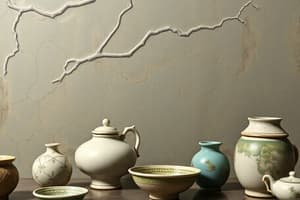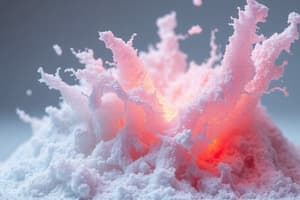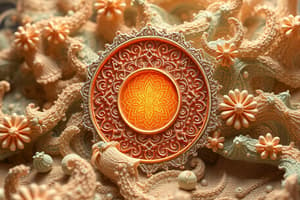Podcast
Questions and Answers
Why does the high hardness of ceramic materials complicate the preparation of the starting powder?
Why does the high hardness of ceramic materials complicate the preparation of the starting powder?
- It causes severe wear and damage during milling. (correct)
- It improves the quality of the final product.
- It simplifies the shaping process.
- It makes the milling process easier.
Which shaping method involves forcing the material through a die to create a specific shape?
Which shaping method involves forcing the material through a die to create a specific shape?
- Injection moulding
- Tape casting
- Slip casting
- Extrusion (correct)
Which method of powder processing involves the use of organic additives and dispersing mechanisms?
Which method of powder processing involves the use of organic additives and dispersing mechanisms?
- Uniaxial pressing
- Agitator ball mill
- Spray dryer (correct)
- Countercurrent jet mill
What is the purpose of isostatic pressing in powder processing?
What is the purpose of isostatic pressing in powder processing?
Why does brittleness facilitate the milling process in ceramic materials?
Why does brittleness facilitate the milling process in ceramic materials?
Which milling method involves particles being ground by colliding with each other in a rotating drum?
Which milling method involves particles being ground by colliding with each other in a rotating drum?
What is a key consideration for the rheology of the suspension in direct ink writing (DWI / Robocasting)?
What is a key consideration for the rheology of the suspension in direct ink writing (DWI / Robocasting)?
What is the purpose of the ink preparation in direct ink writing?
What is the purpose of the ink preparation in direct ink writing?
In ceramic 3D printing using DWI/Robocasting, what is followed after the dry and burn-out stage?
In ceramic 3D printing using DWI/Robocasting, what is followed after the dry and burn-out stage?
What is the primary method employed in three-dimensional printing (3DP) for ceramics?
What is the primary method employed in three-dimensional printing (3DP) for ceramics?
What characterizes the process of powder-based three-dimensional printing (3DP) according to the text?
What characterizes the process of powder-based three-dimensional printing (3DP) according to the text?
Which of the following techniques is NOT typically classified as a powder-based method in additive manufacturing?
Which of the following techniques is NOT typically classified as a powder-based method in additive manufacturing?
Which additive manufacturing technique uses a resin-based Slurry for power source?
Which additive manufacturing technique uses a resin-based Slurry for power source?
In which technique is Binder used during the Three-dimensional printing (3DP) process?
In which technique is Binder used during the Three-dimensional printing (3DP) process?
Which additive manufacturing method utilizes Powder fusion in the Laser-based process of sintering/debinding?
Which additive manufacturing method utilizes Powder fusion in the Laser-based process of sintering/debinding?
Which technique involves Sheet lamination as part of its manufacturing process?
Which technique involves Sheet lamination as part of its manufacturing process?
In which method is Thermal energy used during the Debinding/sintering phase described as Medium speed based?
In which method is Thermal energy used during the Debinding/sintering phase described as Medium speed based?
What is the purpose of adding binders to the sand (SiO2) and water mixture during injection molding?
What is the purpose of adding binders to the sand (SiO2) and water mixture during injection molding?
What is the significance of controlling the rheology of a ceramic suspension in injection molding?
What is the significance of controlling the rheology of a ceramic suspension in injection molding?
Which statement best describes the advantage of injection molding over traditional ceramic processing methods?
Which statement best describes the advantage of injection molding over traditional ceramic processing methods?
What is the purpose of the thermal debinding step in the injection molding process described in the text?
What is the purpose of the thermal debinding step in the injection molding process described in the text?
What is a potential challenge associated with injection molding of ceramics?
What is a potential challenge associated with injection molding of ceramics?
Which statement best describes the future prospects of additive manufacturing of ceramics, according to the text?
Which statement best describes the future prospects of additive manufacturing of ceramics, according to the text?
What is the crucial factor in obtaining final products with good quality in the SLA process?
What is the crucial factor in obtaining final products with good quality in the SLA process?
Which factor(s) can make ceramic particles difficult to process using the SLA method?
Which factor(s) can make ceramic particles difficult to process using the SLA method?
What is the typical activation mechanism for the light-activated polymerization process in SLA?
What is the typical activation mechanism for the light-activated polymerization process in SLA?
Which of the following factors affect the SLA process significantly?
Which of the following factors affect the SLA process significantly?
What is the typical resolution range achievable with the SLA process?
What is the typical resolution range achievable with the SLA process?
Which of the following advanced ceramic parts can be fabricated using SLA?
Which of the following advanced ceramic parts can be fabricated using SLA?
Flashcards are hidden until you start studying




